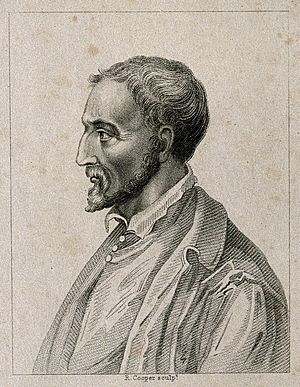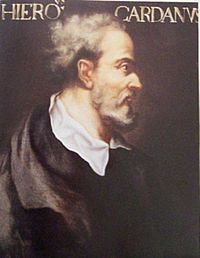Gerolamo Cardano facts for kids
Quick facts for kids
Gerolamo Cardano
|
|
|---|---|

17th-century portrait engraving of Cardano
|
|
| Born | 24 September 1501 |
| Died | 21 September 1576 (aged 74) |
| Nationality | Italian |
| Alma mater | University of Pavia |
| Known for | Cardano–Tartaglia formula First systematic use of negative numbers in Europe |
| Scientific career | |
| Fields | Science, mathematics, philosophy, and literature |
| Notable students | Lodovico Ferrari |
| Influences | Archimedes, Muḥammad ibn Mūsā al-Khwārizmī, Leonardo Fibonacci |
| Influenced | Blaise Pascal, François Viète, Pierre de Fermat, Isaac Newton, Gottfried Wilhelm von Leibniz, Maria Gaetana Agnesi, Joseph-Louis Lagrange, Carl Friedrich Gauss |
Gerolamo Cardano (born September 24, 1501 – died September 21, 1576) was an amazing Italian thinker. He was good at many things, like being a mathematician, doctor, biologist, physicist, chemist, astronomer, and philosopher. He even wrote books!
Cardano was one of the most important mathematicians during the Renaissance. He helped create the idea of probability, which is about how likely something is to happen. He also introduced important math ideas like binomial coefficients and the binomial theorem to the Western world. He wrote over 200 books about science.
He also invented or improved several cool mechanical devices. These include the combination lock and the gimbal. A gimbal uses rings to let a compass or gyroscope spin freely. He also worked on the Cardan shaft with universal joints, which are still used in vehicles today to transfer power. His work on hypocycloids (special curves) helped build early high-speed printing presses.
Today, Cardano is famous for his work in algebra. In his 1545 book Ars Magna, he was the first in Europe to use negative numbers in a clear way. He also shared solutions for cubic and quartic equations and understood that imaginary numbers exist.
Contents
Who Was Gerolamo Cardano?
His Early Life and Studies
Gerolamo Cardano was born on September 24, 1501, in Pavia, Italy. His father, Fazio Cardano, was a smart lawyer and a friend of Leonardo da Vinci.
Cardano had a tough childhood and was often sick. In 1520, he started studying at the University of Pavia. His father wanted him to study law, but Gerolamo loved philosophy and science more.
The university in Pavia closed in 1524 because of a war. So, Cardano moved to the University of Padua. He earned his doctorate in medicine there in 1525. It was hard for him to find a job because he was known for being a bit difficult. He tried to join the College of Physicians in Milan many times but was not allowed in. Still, many doctors asked for his advice because he was so smart.
Becoming a Doctor
Cardano wanted to be a doctor in a big city like Milan. But he couldn't get a license there. So, he went to a smaller town called Piove di Sacco and practiced medicine without a license. In 1531, he married Lucia Banderini. They had three children: Giovanni Battista, Chiara, and Aldo Urbano. Cardano later said these were the happiest times of his life. Lucia passed away in 1546.
Later, some important people helped Cardano get a job teaching mathematics in Milan. He finally got his medical license and worked as both a mathematician and a doctor. He treated many important patients and became one of the most popular doctors in Milan. By 1536, he was so busy with his medical practice that he stopped teaching. He even turned down job offers from kings and queens!
Cardano's Amazing Math Discoveries

Gerolamo Cardano was the first European mathematician to use negative numbers in a structured way. In his important 1545 book, Ars Magna, he shared solutions for cubic equations and quartic equations. These solutions were found by other mathematicians, like Scipione del Ferro and Cardano's student, Lodovico Ferrari.
Cardano also realized that imaginary numbers exist, even though he didn't fully understand them at first. Another Italian mathematician, Rafael Bombelli, later explained them better. In another book, Opus novum de proportionibus, Cardano introduced binomial coefficients and the binomial theorem.
Cardano loved games! He was a skilled gambler and chess player. He even wrote a book called Liber de ludo aleae (which means "Book on Games of Chance"). This book, written around 1564, was published much later in 1663. It was the first time someone explained the ideas of probability in a clear way. He used dice games to understand how probability works. He showed how to figure out the chances of winning by comparing good outcomes to bad outcomes.
Other Cool Inventions and Ideas

Cardano's work with hypocycloids led to something called the Cardan Gear mechanism. This clever gear system helps change spinning motion into straight-line motion very smoothly. He is also known for inventing the Cardan suspension or gimbal, which lets things stay level even when their support moves.
Cardano also studied how liquids move (hydrodynamics). He believed that perpetual motion (a machine that runs forever without energy) was impossible, except for things in space. He wrote two encyclopedias about natural science. These books included many inventions, facts, and even some old beliefs. He also created the Cardan grille in 1550, which was a tool for secret writing (cryptography).
An important part of his work was about the education of the deaf. Cardano believed that deaf people were smart and could learn to read and write without needing to speak first. He was one of the first to say this. He knew about a deaf person who had learned to write, which inspired him.
Cardano also wrote many medical books. Some of his ideas about medicine were very advanced for his time.
People sometimes credit Cardano with inventing "Cardano's Rings" (also called Chinese Rings). However, these puzzles probably existed before him. The universal joint, sometimes called a Cardan joint, was also not actually described by Cardano himself.
Later Life and Legacy

In 1553, Cardano traveled to Scotland to help the Archbishop of St Andrews. The Archbishop had a disease that made him unable to speak. Cardano's treatment worked, and the Archbishop got better! Cardano was paid a lot of money for this successful cure.
Cardano faced some difficult times with his children. His eldest son, Giovanni Battista, was involved in a serious legal case and was put to death. His other son, Aldo Urbano, was a gambler who stole from him.
Cardano moved to Bologna and became a professor of medicine at the University of Bologna. In 1570, he was arrested by the Inquisition, a religious court. They were concerned about some of his writings, especially about astrology. Cardano was held for a few months and lost his teaching job. He was eventually freed, possibly with help from powerful church leaders. However, many of his non-medical books were banned.
He then moved to Rome. There, he received money from Pope Gregory XIII for the rest of his life. He joined the Royal College of Physicians and continued his studies until he passed away in 1576. Gerolamo Cardano was a truly remarkable person who made huge contributions to math, science, and medicine.
Images for kids
See also
Template:KIDDLE XL START  In Spanish: Gerolamo Cardano para niños Template:KIDDLE XL END
In Spanish: Gerolamo Cardano para niños Template:KIDDLE XL END
- Blow book, an early form of art or magic trick initially uncovered by Gerolamo Cardano
- Negative numbers, the core of Cardano's major contributions to science and mathematics



